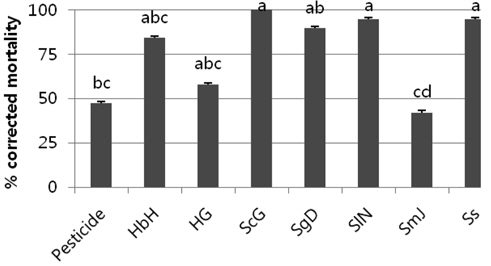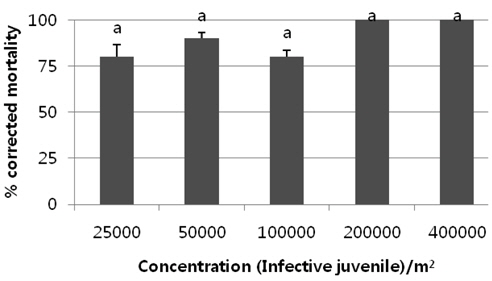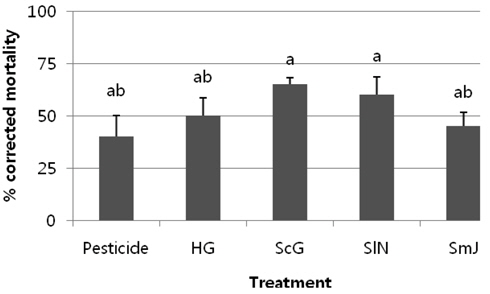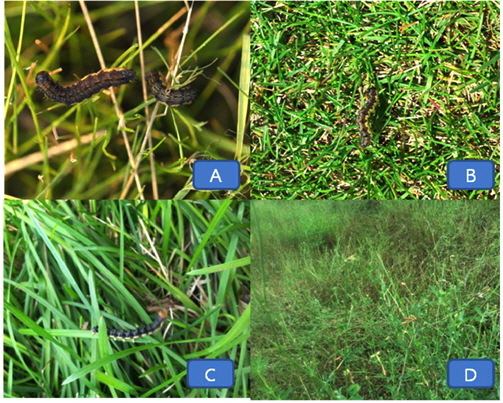실험에 이용한 곤충병원성 선충은 Steinernematidae과의 5종(Steinernema carpocapsae GSN1 strain, S. glaseri Dongrae strain, S. longicaudum Nonsan strain, S. monticolum Jiri strain, S. siamkayai)과 Heterorhabditidae과의 2종(Heterorhabditis bacteriophora Hamyang strain, H. sp. Gyeongsan strain)을 사용하였다. 각각의 선충들은 꿀벌부채명나방(Galleria mellonella) 노숙유충에 증식시켜 사용하였는데(Dutky et al., 1964), White trap을 이용하여 수확한 뒤 9℃ 냉장고에 보관하면서 수확한지 3주 이내의 것을 사용하였다 (Woodring and Kaya, 1988).
멸강나방은 경남 남해군 창선면에 새로 건설한 사우스케이프오너스클럽골프장에서 법면 주변의 잡초를 가해하고 있던 유충을 채집하여 사용하였다. 주로 벌노랑이(Lotus cornicalatus var. japonica Regal)를 집단적으로 가해하고 있어 이곳에서 주로 채집하였다. 채집한 멸강나방은 통풍이 양호한 플라스틱 사육용기(직경 11.5 cm, 높이 8 cm)에 20-30마리씩 기주식물과 함께 넣어 실험실로 가져와 건강한 개체들만 실내 실험에 이용하였다. 그리고 야외실험을 위해서는 톨페스큐(Festuca arundinacea Schreb) 잔디 뗏장을 깐 플라스틱 통(30×36×26 cm)에 60마리씩 방사한 후 실험에 이용할 때까지 사육하였다.
곤충병원성 선충 종별 병원성검정을 위하여 플라스틱화분(직경 16 cm, 높이 15 cm)에 톨페스큐 뗏장(예고 5 cm)을 화분 6 cm 높이에 밀착시켜 넣었다. 그리고 물에 침지 시켜 토양수분을 포화상태로 만들었다. 여기에 야외에서 채집한 멸강나방 5령충을 10마리씩 접종한 후 가정용 핸드스프레이로 각 화분당 곤충병원성 선충 1540마리(m2당 10만 마리 농도)를 20 ml 살포하였다. 대조약제로는 멸강나방 방제용으로 등록되어 있는 클로르피리포스·디플루벤주론수화제를 1000배액으로 희석하여 잔디의 엽면에 충분히 묻도록 살포하였다. 무처리구는 물만 20 ml 살포 하였다. 살포 후 멸강나방이 탈출하는 것을 막기 위하여 그물망으로 화분을 싼 뒤 28℃ 내외의 실험실에 보관하였다. 그리고 처리 7일 후 생존 개체수를 조사하여 치사율을 산정하였다. 실험은 한 개의 화분을 한 반복으로 하여 3반복 처리하였다. 각각의 실험자료들 중 백분율 자료는 arcsin % 변환하여 Tukey test로 분산분석하였으며(Statistix 8, 2003) 결과는 변환전의 값을 표기하였고, 평균±표준오차로 나타내었다.
그 결과 병원성은 곤충병원성 선충의 종에 따라 차이가 많았다(df=8, 18, F=14.6, P<0.0001) (Fig. 1). S. carpocapsae GSN1 strain의 병원성이 가장 높았으나 S. longicaudum이나 S. siamkayai의 병원성도 높았다. 반면 S. monticolum과 대조약제로 사용한 클로르피리포스·디플루벤주론 수화제는 50%이하의 보정사충률을 보였다.
실내 병원성 검정에서 병원성이 가장 높았던 S. carpocapsae GSN1 strain을 이용하여 멸강나방 5령충에 대한 농도별 병원성을 검정하였다. 실험은 곤충병원성 선충 종별 병원성 검정과 같은 방법으로 수행하였다. S. carpocapsae GSN1 strain의 처리 농도는 각각 0, 385, 770, 1,540, 3,080, 6,160마리(0, 25,000, 50,000, 100,000, 200,000, 400,000마리/m2)였고 각 화분에 살포하였다. 한 개의 화분을 한 반복으로 3반복 처리하였으며 7일 후 생충수를 조사하여 치사율을 구하였다.
그 결과 S. carpocapsae GSN1 strain을 m2당 25,000마리-400,000마리 처리하였을 때 멸강나방 5령충의 보정사충율은 80%이상이었다. 농도에 따른 병원성에서 통계적 유의성은 인정되지 않았다(df=5, 12, F=12.3, P<0.0002) (Fig. 2).
멸강나방에 대한 곤충병원성 선충의 야외 효과시험은 2013년 8월 7일 경남 남해의 사우스케이프오너스클럽골프장 톨페스큐 포장에서 수행하였다. 톨페스큐 포장에 직경 38 cm, 높이 15 cm 철재 링을 2 cm 깊이로 박고는 채집해서 실내에 사육하던 멸강나방 5령충 10마리씩을 방사하였다. 여기에 실내 병원성 검정에서 병원성이 가장 높았던 S. carpocapsae GSN1 strain, S. longcaudum Nonsan strain과 병원성이 낮았던 Heterorhabditis sp. Gyeongsan strain와 S. monticolum Jiri strain을 m2당 100,000마리 농도로 각각의 구에 가정용 분무기로 150 ml씩 살포하였다. 선충 살포 전 선충의 토양 이동과 습도 보존을 위하여 모든 처리구에 m2당 4 L씩의 물을 관수하였다. 대조약제로 클로르피리포스·디플루벤주론수화제를 권장량인 1000배액으로 희석하여 잔디 잎이 충분히 젖을 정도로 살포하였다. 처리 후 링의 위 3 cm부분을 바셀린으로 도포하여 멸강나방이 탈출하지 못하게 하였고, 조류에 의한 피해를 막기 위하여 곡물 망으로 링을 덮었다. 무처리구는 물만 처리하였고 한 개의 링을 한 반복으로 3반복 처리하였다. 처리 7일 후 치사 된 개체를 조사하였으며 관수는 일반 관리와 동일하게 매일 1회 스프링클러로 하였다. 처리 당일의 평균기온은 28.9℃ 최고기온과 최저기온은 각각 34.7℃와 24.1℃였고 조사기간 동안 강수는 없었다.
야외에서 곤충병원성 선충의 멸강나방에 대한 치사율은 실내 실험에 비하여 낮았다(Fig. 3). 효과가 가장 좋았던 S. carpocapsae GSN1 strain의 멸강나방에 대한 보정사충율은 65%였다. 그리고 그 외의 선충도 대조약제보다는 높은 치사율을 나타내었다(df=5, 12, F=4.02, P<0.02).
곤충병원성선충은 멸강나방 5령충에 대하여 종별로 차이는 있지만 실내실험에서 높은 병원성을 나타내었다. 특히 S. carpocapsae GSN1 strain의 경우 일반적인 곤충병원성선충의 야외적용 농도인 m2당 10만 마리 이하의 농도에서도 높은 병원성을 보였다. S. carpocapsae GSN1 strain은 다양한 종류의 해충들에 대하여 병원성을 보이고 있는 데 특히 나비목 해충에 대한 병원성이 높은 편이다(Choo et al., 2002; Kang et al., 2004). 한편 본 실험에서는 노숙유충인 5령충을 이용하여 병원성을 검정하였는데 동일한 밤나방과 해충들인 잔디밤나방이나 거세미나방에 비하여 상대적으로 높은 병원성을 보였다(Lee et al., 1997; Kang et al., 2004). 잔디밤나방의 경우 2령충이 가장 감수적이며 이후 병원성이 감쇠하여 5령충의 경우 병원성이 현저히 감소하여 20%이하의 보정사충률을 보였는데(Kang et al., 2004) 멸강나방에 대해서는 100% 치사율을 보여 멸강나방이 곤충병원성선충에 상대적으로 감수적인 것으로 판단된다. 또한 곤충병원성선충의 농도별 처리시에도 야외 적용 농도의 ¼농도부터 4배 농도까지 통계적 유의성이 없이 높은 병원성을 나타내어 이러한 요인도 멸강나방이 곤충병원성선충에 대해 감수성이 높기 때문으로 생각된다.
곤충병원성선충의 종이나 계통, 기주의 종류와 발육단계는 곤충병원성선충의 병원성에 영향을 미치는 주요 인자들이며 이들은 기주의 면역반응이나 곤충병원성선충 공생세균의 독성과 관련이 있다(Dowds and Peters, 2001; Han et al., 2012).
실내실험에서 곤충병원성선충이 멸강나방에 대하여 높은 병원성을 보였음에도 불구하고 야외실험에서는 낮은 치사율을 보였다. 이는 실내실험의 경우 충분한 관수로 토양 수분이 충분하고, 자외선이 차단되는 실내였으며 26℃ 내외로 온도가 유지되어 상대적으로 낮은 토양수분과 자외선 노출, 평균온도는 29℃ 내외이나 35℃에 이르는 고온에 노출되어 있는 야외 환경조건으로 인하여 낮은 병원성을 보인 것으로 판단된다. 토양수분이 많을수록 곤충병원성선충의 병원성은 높아지며 직사광선이나 자외선 조사시간이 짧을수록 병원성에 영향을 적게 받는다(Lee et al., 2006a, 2010). S. carpocapsae GSN1 strain의 경우 30℃까지는 병원성이 높아지나 35℃에서는 감소하였다(Choo et al., 2002).
본 실험은 멸강나방이 골프장 코스 내에 예고가 짧은 잔디보다 예고가 긴 법면 주변의 톨페스큐 주변에서 활동이 많고, 기주의 식이 활동도 법면지역에서 많아(Fig. 4) 코스 내의 잔디보다 예고가 높은 톨페스큐 포지에서 실험을 수행하였는데 이러한 요인도 곤충병원성선충의 효과에 영향을 미쳤을 것으로 추정된다. 잔디의 예고는 곤충병원성선충이나 살충제의 효과에 영향을 미치는데 잔디의 길이가 길수록 효과가 감소된다(Kang et al., 2004; Lee et al., 2006b). 실험을 수행한 포지의 톨페스큐 잔디 높이는 10 cm내외로 일반적으로 골프장에서 관리되고 있는 잔디의 예고에 비하여 현저히 높은 편이었다. 또한 톨페스큐잔디 자체가 라이그라스나 켄터키블루그라스에 비하여 긴 세엽들이 많이 엉켜 있어 곤충병원성선충의 기주 접촉이나 침입에 장애가 되었을 것으로 생각된다.
비록 멸강나방의 령기별에 따른 곤충병원성선충의 병원성에 대한 연구를 수행하지 못하였지만 노숙유충인 5령충에 대하여 다른 밤나방류에 비하여 높은 병원성을 가지고 있음이 확인되어 환경친화적 방제가 필요한 곳에서 곤충병원성선충의 활용이 가능할 것으로 생각된다.








